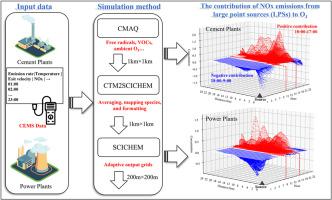Evaluating Near-Field Effects of Large Point Source Emissions on Ambient Ozone with Coupled Lagrangian and Eulerian Models
IF 7.3
2区 环境科学与生态学
Q1 ENVIRONMENTAL SCIENCES
引用次数: 0
Abstract
Understanding and managing the near-field impacts of large point sources (LPSs) on ozone (O3) pollution is critical for effective urban air quality control. This study integrated a Lagrangian-Eulerian modeling framework that combines the Second-Order Closure Integrated Puff with chemistry (SCICHEM) model and the Community Multiscale Air Quality (CMAQ) model (referred to as SCICHEM-CMAQ), to quantify O3 responses to nitrogen oxides (NOx) emissions from cement and power plants, with support from Continuous Emission Monitoring System (CEMS) data. Results revealed that both source types exhibit pronounced peak impacts during late morning to early afternoon hours (10:00-14:00), coinciding with intensified photochemical activity. For instance, peak O3 contributions reached up to 1.78 μg/m3 and 1.52 μg/m3 for cement and power plants, respectively. In terms of continuous emissions, cement plants exert the strongest influence within 0-2 km through rapid mixing and stronger local photochemical formation, while both cement and power plants make high O3 contributions again within a range of 5-13 km via regional transport and sustained chemical processes, forming exposure hotspots of regulatory concern. This spatial differentiation reveals overlooked far-field persistence beyond conventional near-field assessments. Wind-resolved analysis indicated that continuous industrial NOx emissions can exert stronger effects in downwind regions than near the source, highlighting their extended influence range.

用拉格朗日和欧拉耦合模型评价大点源排放对环境臭氧的近场影响
了解和管理大型点源对臭氧(O3)污染的近场影响,对于有效控制城市空气质量至关重要。本研究整合了拉格朗日-欧拉建模框架,该框架结合了二阶封闭综合化学(SCICHEM)模型和社区多尺度空气质量(CMAQ)模型(简称SCICHEM-CMAQ),在连续排放监测系统(CEMS)数据的支持下,量化了水泥和发电厂对氮氧化物(NOx)排放的O3响应。结果表明,在上午晚些时候到下午早些时候(10:00-14:00),两种来源的影响均达到峰值,与光化学活性增强相一致。例如,水泥和电厂的O3贡献峰值分别达到1.78 μg/m3和1.52 μg/m3。在持续排放方面,水泥厂通过快速混合和更强的局部光化学形成,在0-2 km范围内影响最大,而在5-13 km范围内,水泥和发电厂通过区域运输和持续的化学过程,再次产生较高的O3贡献,形成监管关注的暴露热点。这种空间分异揭示了传统近场评估所忽略的远场持久性。风分辨分析表明,持续的工业NOx排放对下风区域的影响比源附近更强,突出了其扩展的影响范围。
本文章由计算机程序翻译,如有差异,请以英文原文为准。
求助全文
约1分钟内获得全文
求助全文
来源期刊

Environmental Pollution
环境科学-环境科学
CiteScore
16.00
自引率
6.70%
发文量
2082
审稿时长
2.9 months
期刊介绍:
Environmental Pollution is an international peer-reviewed journal that publishes high-quality research papers and review articles covering all aspects of environmental pollution and its impacts on ecosystems and human health.
Subject areas include, but are not limited to:
• Sources and occurrences of pollutants that are clearly defined and measured in environmental compartments, food and food-related items, and human bodies;
• Interlinks between contaminant exposure and biological, ecological, and human health effects, including those of climate change;
• Contaminants of emerging concerns (including but not limited to antibiotic resistant microorganisms or genes, microplastics/nanoplastics, electronic wastes, light, and noise) and/or their biological, ecological, or human health effects;
• Laboratory and field studies on the remediation/mitigation of environmental pollution via new techniques and with clear links to biological, ecological, or human health effects;
• Modeling of pollution processes, patterns, or trends that is of clear environmental and/or human health interest;
• New techniques that measure and examine environmental occurrences, transport, behavior, and effects of pollutants within the environment or the laboratory, provided that they can be clearly used to address problems within regional or global environmental compartments.
 求助内容:
求助内容: 应助结果提醒方式:
应助结果提醒方式:


